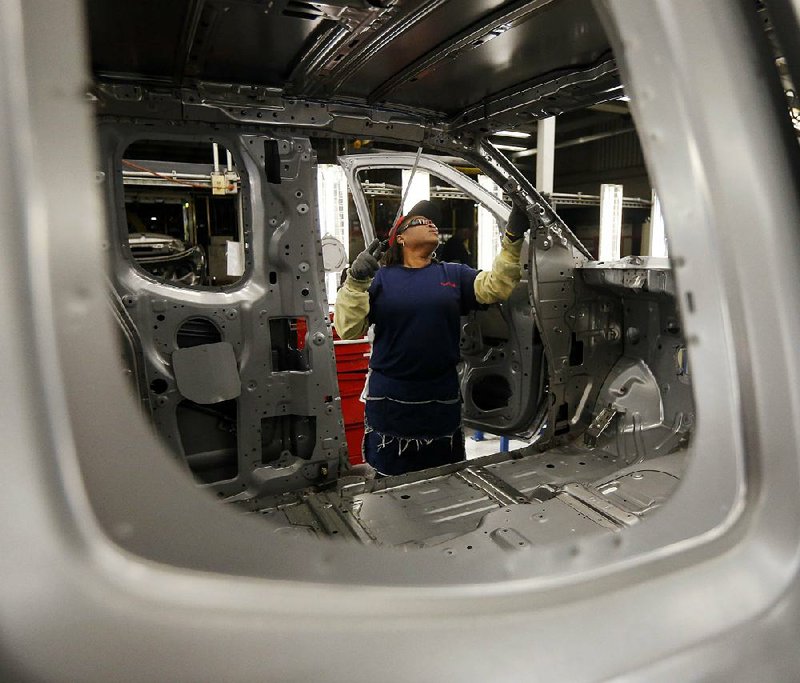WASHINGTON -- Orders to U.S. factories for long-lasting manufactured goods rose in March, but a key category that tracks business investment plans was weak for a second month.
Orders for durable goods increased 0.8 percent, rebounding partially from a 3.1 percent tumble in February, the Commerce Department reported Tuesday. The result was fueled by a jump in demand for military equipment, a volatile category.
The economic report was one of three released Tuesday that included a measure of U.S. home prices for February and consumer confidence in April.
Excluding defense, durable goods orders would have fallen 1 percent in March, the Commerce Department reported.
Demand in a category that serves as a proxy for business investment plans was flat in March after a 2.7 percent drop in February.
Jenifer Lee, senior economist at BMO Capital Markets, called the March orders report "very disappointing," with business investment soft as the first quarter ended.
She noted that the investment category has risen only once in the past five months. The flat reading in March indicated "little-to-no momentum" heading into the second quarter, she said.
"At best you're treading water here," said Jacob Oubina, a senior U.S. economist at RBC Capital Markets LLC in New York. "There is a general carving out of a bottom in the weakness that's plagued the manufacturing space, but I don't think we're heading into a significantly more upbeat backdrop unless you start to see a firmer recovery in oil."
Manufacturing has been under pressure for the past year, reflecting global weakness, a strong dollar and falling oil prices.
Prospects for 2016 remain uncertain. Some economists believe that U.S. factories should see a pickup in demand since the dollar has stopped strengthening against other currencies. The global economy also seems to have stabilized after a shaky start to the year. But other analysts are uncertain about how long it might take for manufacturing to bounce back.
For March, overall defense orders surged by 38.6 percent, led by a 65.7 percent increase in demand for military aircraft and parts. But the 1 percent decline in demand outside of defense reflected weakness in a number of areas.
Orders for commercial aircraft, another volatile category, fell 5.7 percent after a 26.6 percent drop in February. Orders for motor vehicles and parts dropped 3 percent. Demand for appliances and other electrical equipment also declined 3 percent.
Demand for primary metals such as steel rose 0.8 percent, and demand for machinery was up 0.5 percent.
Home prices in 20 U.S. cities rose less than forecast in February from a year earlier, which bodes well for prospective buyers.
The S&P/Case-Shiller index of property values in 20 cities increased 5.4 percent from February 2015, the smallest gain since October, after climbing 5.7 percent in the year ended in January, a report from the group showed Tuesday in New York. Nationally, prices rose 5.3 percent year-over-year.
Measured price gains may bring home ownership within reach of more Americans, especially first-time buyers and those with low incomes. The additional support is needed, especially with wages remaining sluggish, as recent reports showed demand lacked momentum heading into the busiest selling season of the year.
All 20 cities in the index showed a year-over-year gain, led by an 11.9 percent increase in Portland, Ore. Seattle and Denver showed the second- and third-fastest rates of appreciation.
U.S. consumers were feeling a little less confident in April, even though the stock market was rebounding from its February lows.
The Conference Board said Tuesday its consumer confidence index dropped to 94.2 this month after rising to 96.1 in March.
The April report showed confidence on a sideways path, with modest progress in one month followed by a slight retreat in the following month.
Consumers' assessment of current conditions improved in April, which could suggest that the economy is growing at a stable pace. But their expectations for the future fell to a two-year low.
Paul Ashworth, chief U.S. economist at Capital Economics said that the recent rise in gasoline prices seemed to be offsetting the rebound that has occurred in the stock market.
"Consumer confidence has trended lower in recent months, but the fundamentals for consumption remain encouraging," Ashworth said.
Information for this article was contributed by Martin Crutsinger of The Associated Press, Victoria Stilwell and Shobhana Chandra of Bloomberg News.
Business on 04/27/2016

